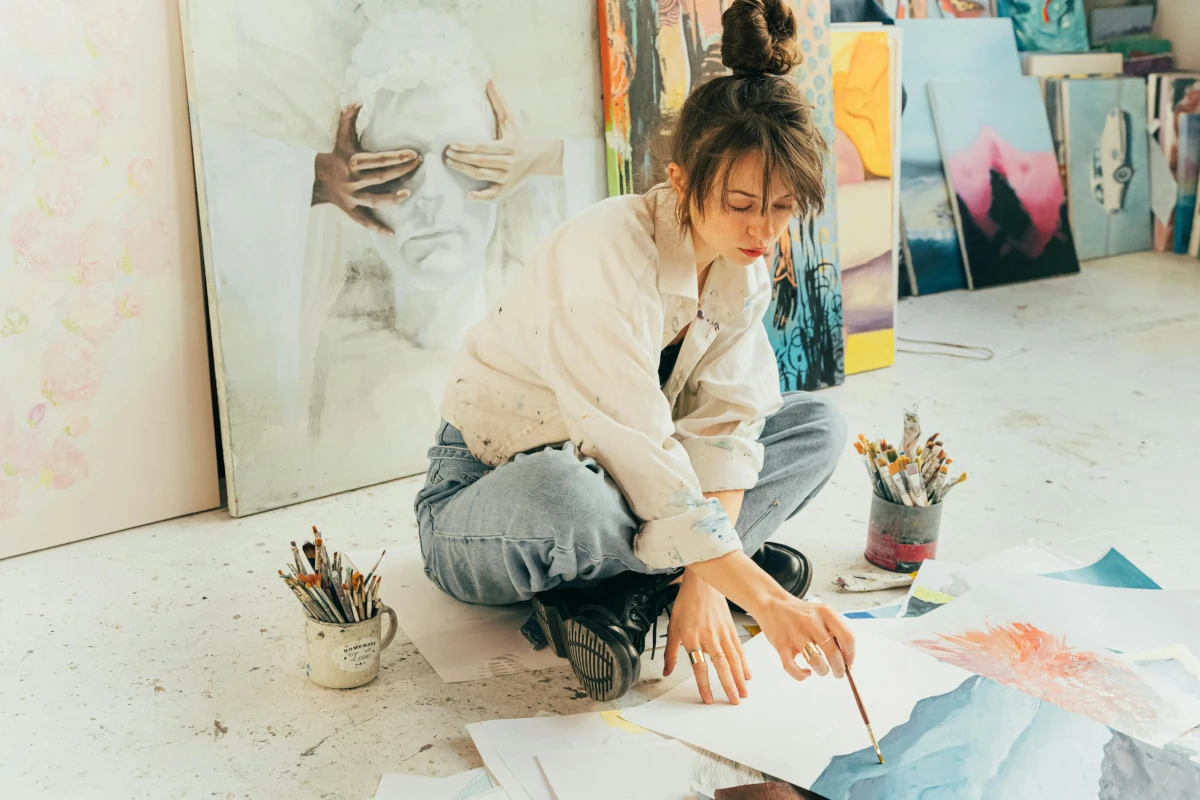ADHD and the Creative Brain: Strategies for Staying Engaged
As both a psychotherapist and an artist living with ADHD, I know firsthand how complex the creative ADHD brain can be. The same mind that brims with inspiration and originality can also struggle with organization and consistency. In creative fields where structure is often fluid, ADHD can feel like both a superpower and a stumbling block. The good news? You’re not alone, and there are strategies that truly help. In this post, I’m sharing what I’ve learned from both my clinical work with ADHD clients and my personal experience to help you work with your brain, not against it.
Understanding the ADHD–Creativity Connection
Why ADHD Brains Are So Creative
ADHD brains are wired for novelty. Many of us are idea generators and natural risk-takers who thrive on big-picture thinking. We tend to be highly sensitive to stimuli and emotions, which means we can tap into nuanced perspectives that fuel art, storytelling, design, and innovation. Dopamine, the neurotransmitter that regulates reward and motivation, plays a significant role in ADHD. Because we seek dopamine, we’re drawn to tasks that feel exciting and new.
This is a gift in creative industries where innovation and originality are essential. However, the very things that make our brains creative can make it difficult to stay focused, finish projects, and maintain consistent energy. Our attention is often scattered across multiple passions, making deep, sustained focus a challenge.
Common Challenges for Creative Professionals with ADHD
Some of the most common struggles I hear from clients (and have experienced myself) include:
- Starting projects with energy but losing steam halfway through
- Feeling overwhelmed by deadlines, details, or admin tasks
- Struggling to organize ideas into a finished product
- Being sensitive to rejection or self-doubt, leading to avoidance
- Difficulty switching gears between creative and structured work
These challenges don’t mean you’re failing—they just mean you need a different framework to support your unique mind.
Strategy One: Work With Your Rhythms, Not Against Them
Learn Your Attention Cycles
If you have ADHD, your attention isn’t constant—it comes in waves. One of the most helpful shifts is learning to track and honour your focus cycles. Notice when your brain feels most alert. Is it late at night? Right after exercise? After a shower or engaging with certain content?
Use those peak windows for your most creative work. During lower-energy times, tackle admin or physical tasks that don’t require as much cognitive effort. This isn’t lazy—it’s efficient. Your brain isn’t broken, it’s rhythmic. Respecting those rhythms can increase productivity and reduce burnout.
Time-Boxing With Flexibility
Time-boxing is a great strategy for ADHD brains—if it’s used creatively. Instead of rigid blocks, think of time as containers for themes. For example, create a "Creativity" block from 9:00 to 11:00 for creative tasks and an "Admin" block after lunch. Notice which tasks energize you and which ones tend to drain you. Can you incorporate energizing elements into the more draining ones? Be creative and stay curious—you’re learning what supports your brain best, and that takes time.
Use a visual timer or app that shows time passing. This helps you stay anchored in the present without relying on internal cues. Over time, you’ll build a more intuitive understanding of how long tasks actually take.
Strategy Two: Externalize and Contain Your Ideas
Use Tools as Extensions of Your Brain
Your brain holds a lot—ideas, emotions, inspirations, worries. Rather than managing all of it internally, get into the habit of externalizing. Use tools like whiteboards, sketchbooks, apps, sticky notes, or voice memos to capture your thoughts in real time. Conquer the “out of sight, out of mind” challenge of ADHD by making your tasks and emotions visible and tangible.
Think of these tools not as reminders of what you “should” be doing, but as compassionate supports that hold your ideas for you until you’re ready. The goal is to reduce mental clutter, which can be a major source of stress and distraction.
Create Creative Containers
Too many ideas can be paralyzing. Try creating designated spaces for different types of inspiration. For example:
- A journal for raw ideas
- A folder for visual inspiration
- A digital board for long-term project plans
- A notebook for works-in-progress
This makes your creative life feel more manageable. When your ideas have homes, you’re more likely to return to them and complete what you start.
Strategy Three: Make Structure Feel Inviting, Not Rigid
Repairing Motivation After Rejection Sensitivity
Rejection sensitivity is a deeply personal and often painful part of life with ADHD. Many of us feel things intensely, especially when it comes to creative work. A piece of feedback, a lack of response, or even a moment of self-doubt can spiral into avoidance and paralysis. The work we once loved can suddenly feel too vulnerable to return to.
When this happens, the key is gentle re-entry. Start by identifying the smallest, least emotionally charged step you can take—opening the file, rereading a paragraph, or setting a five-minute timer. The goal is to lower the emotional barrier enough that you can begin again without pressure to produce something perfect.
It can also help to externalize your emotional response. Write about what triggered the shutdown. Validate it. You’re not overreacting—you’re feeling deeply because you care. Then, reconnect with your purpose: Why did this creative idea matter to you in the first place?
Finally, enlist support. Reach out to someone who understands your process and can reflect your strengths back to you. In moments when self-doubt takes over, connecting with a friend who helps you feel seen and grounded can make all the difference. Let them co-regulate with you—talk it through, take a walk together, or just sit in shared company. Once your nervous system feels settled, try re-approaching your work with fresh eyes and a softened heart. Creative work is brave work. Give yourself credit for every time you come back to it.
Design Routines That Fit Your Brain
Traditional advice around “discipline” or “consistency” can feel punishing for ADHD minds. Instead, aim to create rituals that feel rewarding and motivating. Think of it like designing a morning routine that gently ushers you into work—light a candle, listen to your favourite song, stretch, then open your project.
Habit stacking means pairing a new habit with an existing one you already do regularly. For example, you might open your creative project file immediately after making your morning coffee, or do a five-minute journaling session after brushing your teeth. By attaching a new creative habit to a reliable, established routine, you reduce the mental effort needed to get started. Over time, these small, linked actions build momentum and create a sense of flow that feels natural and less overwhelming.
When structure feels like a ritual instead of a rule, you’re more likely to return to it.
Set the Scene for Engagement
Your environment matters more than you think. ADHD brains are highly responsive to sensory input. Set up a workspace that feels visually clear and comfortable. That might mean noise-cancelling headphones, a mood light, or switching locations midday. For myself, I find that different environments support different activities. For focused, admin-related work, I need a space with minimal visual distractions. For more creative work, I work best surrounded by noise, colour, and visual inspiration.
Small adjustments can increase your sense of focus and control. Give yourself permission to experiment with what works. Structure doesn’t mean restriction—it can mean safety, clarity, and creative freedom.
You Can Create Your Own Framework
Having ADHD doesn’t mean you’re unreliable or inconsistent. It simply means your brain is wired in a unique way. When we understand our rhythms, externalize our ideas, and design flexible structures, we unlock the full potential of the creative ADHD brain. You don’t need to change who you are—just how you support yourself!
Whenever it feels right, try one of these approaches. Only you know what works best for your unique needs, and it’s okay to be in a discovery phase of what helps.
Wishing you all the best as you continue offering your creativity and art to the world—because the unique gifts you share enrich not only your own life but also inspire and uplift those around you. You’ve got this, and I’m cheering you on every step of the way!
Ready to explore more about ADHD and creativity? Check out our other mental health resources or book a session to keep your creative journey moving forward.



















